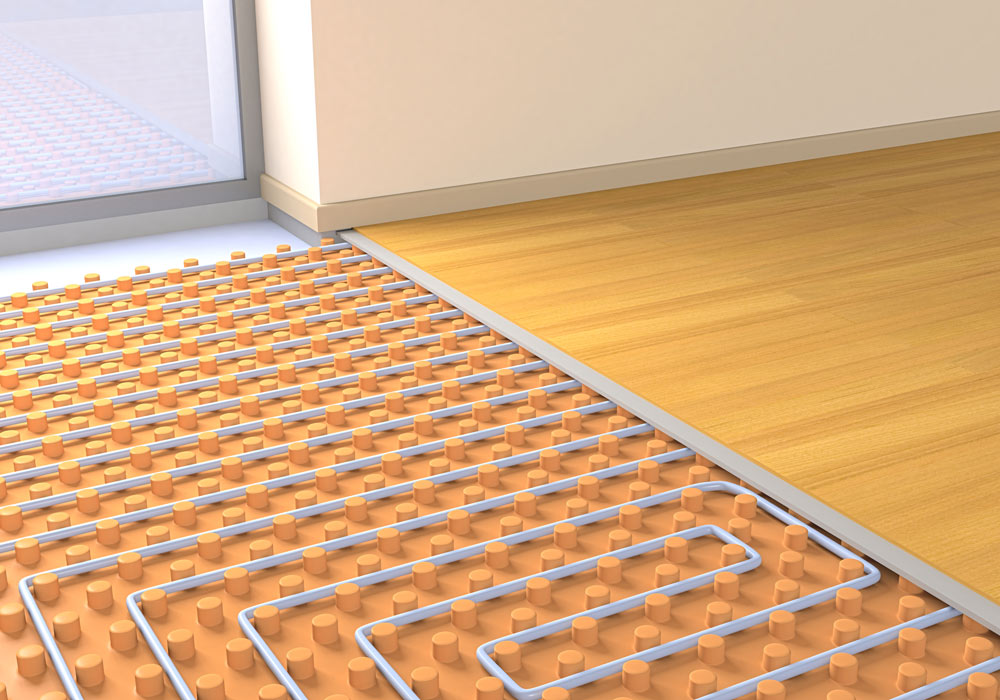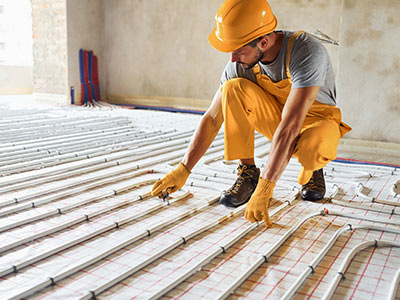Back to Wood Floor Fitting
Wood Flooring And Underfloor Heating

If you're considering installing an underfloor heating system beneath your solid, engineered, or laminate flooring, it’s crucial to understand the requirements and recommendations from manufacturers and contractors regarding compatibility. While an underfloor heating system can be a smart investment for many households, not all indoor environments and floor coverings are suitable for it.
Key Considerations:
- Compatibility: Ensure your chosen flooring can accommodate a heating system underneath without compromising its integrity.
- Type of Flooring: Not all wood or laminate floors respond well to underfloor heating.
Today’s article will help you grasp the essentials of underfloor heating systems, ensuring a smooth installation while maintaining the perfect condition of your wood or laminate floor.
Types of Underfloor Heating Systems
When considering underfloor heating, it’s essential to know that there are two main types of systems:
Electric Underfloor Heating:
- Higher Temperatures: This system provides higher temperatures for a cosy feel, especially in winter, making it ideal for spaces where warmth is paramount, such as bathrooms and living areas.
- Energy Efficiency: Electric systems can lead to lower heating bills due to increased efficiency, as they allow for precise control of heating zones, ensuring that you only heat the areas that are in use.
- Compatibility Concerns: However, it’s important to note that electric underfloor heating may not be suitable for all types of hard flooring, particularly solid wood or laminate, as these materials can be sensitive to temperature fluctuations. The risk of expansion and contraction could lead to gaps or warping over time, so proper consultation with a flooring professional is recommended before installation.
Water-Based Heating Systems:
- Circulating Hot Water: This system involves pipes installed under the floor covering that circulate hot water, providing a consistent and even heat distribution throughout the space.
- Energy Efficiency for Larger Areas: Water-based systems are often more energy-efficient, especially for larger areas, as they can maintain a lower water temperature while still providing effective heating. This makes them a great choice for whole-house heating solutions.
- Installation Considerations: While these systems can be more efficient, they may require more extensive installation work and are typically better suited for renovations or new builds rather than retrofitting existing flooring.
Understanding these options will help you make an informed decision about the best heating solution for your home while preserving the beauty and durability of your wood flooring. By weighing the benefits and potential drawbacks of each system, you can select an underfloor heating solution that complements your lifestyle and enhances the comfort of your living spaces.
Compatibility of Electric Underfloor Heating with Wood Flooring
Electric underfloor heating is not highly recommended for installation beneath solid wood or laminate flooring. The primary concern is that both types of flooring are sensitive to temperature fluctuations, which can lead to excessive movement of the floorboards. This movement is primarily caused by the shrinking and expanding of the boards, resulting in potential issues that may require professional intervention, such as a wood floor repair service.
Potential Issues with Electric Underfloor Heating:
- Gaps Between Boards: Excessive movement can create gaps, particularly in laminate flooring where the top lamella layer may shrink.
- Decreased Stability: These gaps can significantly reduce the stability of your flooring construction, leading to long-term problems.
Engineered Wood Flooring and Underfloor Heating
In contrast, the scenario changes when considering engineered wood flooring with underfloor heating. Engineered wood floorboards are constructed from real wood and lumber products, making them a man-made, high-quality wood flooring option. Their design aims to be less susceptible to moisture, humidity, and temperature changes that can adversely affect solid wood.
Benefits of Engineered Wood Flooring:
- Reduced Sensitivity: Engineered wood is specifically designed to minimise the common issues associated with solid wood flooring.
- Structural Stability: The unique structure of engineered wood helps it maintain stability under varying environmental conditions, making it a suitable choice for homes with underfloor heating systems.
By choosing engineered wood flooring, you can enjoy the benefits of underfloor heating without compromising the integrity of your flooring.
Structure of Engineered Wood Flooring
Engineered wood flooring consists of multiple layers:
- Softwood and Plywood: Layers of softwood and plywood (or other wood/lumber products) are glued and pressed together in a crisscross pattern.
- Hardwood Layer: The top layer is made from a hardwood species, which can vary in thickness.
Thanks to this specific structure, engineered wood floors are less prone to issues caused by the movement of floorboards. This makes electric underfloor heating a viable option for engineered wood flooring. However, it is highly recommended to consult a wood flooring professional before making any decisions and to heed their advice!
Understanding Underfloor Heating Systems
 To maximise the benefits of underfloor heating, it’s important to understand its operational parameters:
To maximise the benefits of underfloor heating, it’s important to understand its operational parameters:
- Water Temperature: The highest temperature of a water-based underfloor heating system should not exceed 28 degrees Celsius. This means that the temperature of the heating system's water should be maintained between 35-38 degrees Celsius to achieve a surface temperature of 28 degrees.
- Temperature Change: It's crucial to ensure that the temperature does not change by more than 5 degrees Celsius within 24 hours.
The best way to learn about these common recommendations is to discuss them with the underfloor heating manufacturer or a professional wood flooring contractor. This will allow you to extract important information and recommendations tailored to your specific situation.
Importance of Temperature Control
Having a remote control system for your underfloor heating allows you to manage and maintain the temperature effectively, ensuring optimal conditions for your wooden or laminate flooring.
Pre-Installation Checks
Before installing your flooring, the underfloor heating installation contractor should assess the heating system's performance. This step is essential to identify and address any unexpected issues, allowing for repairs or replacements without the stress of dealing with problems once the floor is already installed.
How to Check Your Underfloor Heating System
To ensure your underfloor heating system is functioning properly, follow this step-by-step guide:
-
Gradual Temperature Increase:
- For 4 to 5 days, gradually raise the temperature of the heating system by 3 to 5 degrees Celsius each day.
- Monitor the system for any irregularities during this time.
-
Maintain Maximum Temperature:
- Once you reach the maximum recommended temperature, allow the heating system to run for seven days without adjusting the temperature levels.
-
Gradual Temperature Decrease:
- After a week at maximum temperature, gradually lower the temperature again, 3 to 5 degrees Celsius per day, for another week.
-
System Shutdown:
- Turn off the underfloor heating system for 2 to 3 days.
-
Professional Inspection:
- After the shutdown, contact a professional to inspect the condition of the insulation membrane installed over the heating system. The professional will check for:
- Scratches
- Scuffs
- Gaps
- Holes
The insulation sheet must be in pristine condition. Any damage could cause excessive heat to escape through gaps and holes, potentially ruining your wooden floor.